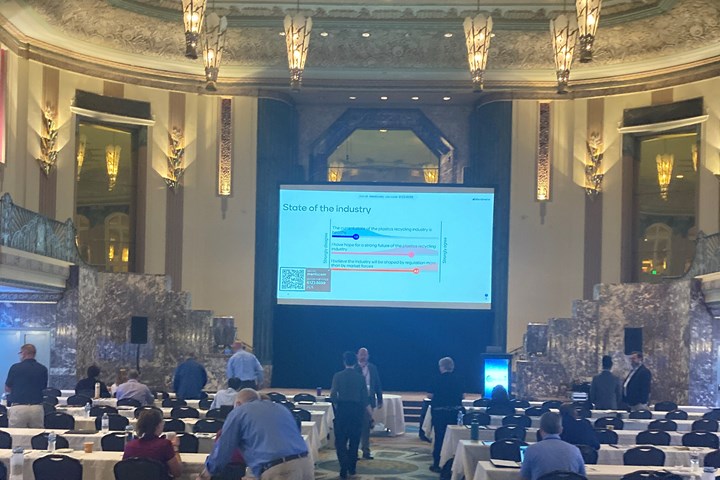Recycling Leaders Meet to Explore Economic and Technical Challenges
Baerlocher hosted its second annual recycling summit, featuring pragmatic discussion covering the entire value chain.
Stakeholders in the plastics recycling market assembled in Cincinnati August 22 & 23 for the second annual Baerlocher Recycling Summit. The diversity of participants spanned production, consumer brand, material conversion, equipment supply, and material recovery. Speakers offered a variety of insights on the looming challenge of increasing the recycled portion of plastics production against the headwind of sluggish prices (pricing for regrind and reprocessed plastics have remained low throughout 2023, according to reports from the Oil Price Information Service).
Processing Recycled Resin: Challenges and Strategies
Jens Schuelter, of equipment supplier W. Muller, shared results of testing that company does to understand the challenges in processability, appearance, and mechanical properties encountered by their customers, with examples of how formulation changes can help meet specifications—even with PCR materials other than the best quality HDPE.

Recycling leaders met amid uncertainty about economic drivers and policy directions.
Photo Credit: Matt Stonecash
Nate Miranda, of Transcontinental Packaging, spoke of the challenges in using recycled material in shrink collation films, where paper labeling, adhesives, varying content, and even inconsistent pellet sizes can create processing issues.
Robert Sherman, technical director at Baerlocher, explained the chemical mechanisms of degradation introduced by recycling processes, and how stabilization can mitigate the effects. “Recycling involves heat and shear, the two worst things you can do to a polymer,” said Sherman. Joe Palmer, of Altium, also attributed much of the difficulty dealing with recycled materials to degradation from heat cycle history. Palmer described analysis and design strategies to prevent common product failure modes.
Price Gap Between Recycled and Virgin Material
Given the amount of work and expertise required to access the value in recycled plastic, it should be no surprise that its production costs more than simply making new virgin plastic. It is not clear where in the value chain that cost can be absorbed in the current environment.
Ben Ma, associate research director at The Clorox Company, expressed skepticism that consumers would be willing to pick it up: “People say they will spend more money on a sustainable product. But if you put money in their pocket and send them to the store, you’ll find out what they really buy.”
Greg Janson, president at Granite Peak Plastics, and Steve Alexander, president at the Association of Plastic Recyclers (APR), both cited competition from wide-spec virgin resin as a downward pressure on recycled material prices. According to Janson, opportunities in durable goods could help make demand more predictable and prices more competitive in the long term. “We have a viable recycling industry because of durables, not packaging”, said Janson.
Others opined that recycled plastics would never be consistently competitive to virgin material on a cost basis. “The cost of PCR may have been less than virgin at one point, but that was a moment in history. It costs money to recycle,” said Jean Bina, director of sales and market development at Envision Plastics.
Despite the challenges, live polling conducted at the summit showed that many participants were optimistic about the future of plastics recycling. Views on extended producer responsibility laws and recycled content mandates were diverse, but the general sentiment was that policy would play an indispensable role in the future of recycling.
Data presented by APR’s Steve Alexander may have been part of the optimism. According to a report prepared by Stina, five billion pounds of plastic was recycled in North America in 2021, and 90% of plastic collected for recycling was processed within North America.
Organizers from Baerlocher closed by soliciting feedback on the content of the summit, with the aim of incorporating in its next iteration in 2024.
Related Content
Mold Opaque White PET Bottles – Without Pigment
Trexel and Husky are cooperating on molding recyclable opaque white preforms for PET bottles, which provide a light barrier using foam instead of pigment.
Read MoreGet Color Changes Right In Extrusion Blow Molding
Follow these best practices to minimize loss of time, material and labor during color changes in molding containers from bottles to jerrycans. The authors explore what this means for each step of the process, from raw-material infeed to handling and reprocessing tails and trim.
Read MoreHow Inline Vision Inspection Can Minimize Scrap in Molding
Once viewed by injection and blow molders as a necessary evil, machine vision technology today can continuously monitor and improve production while reducing costs.
Read MoreAt NPE, Cypet to Show Latest Achievements in Large PET Containers
Maker of one-stage ISBM machines will show off new sizes and styles of handled and stackable PET containers, including novel interlocking products.
Read MoreRead Next
Understanding Melting in Single-Screw Extruders
You can better visualize the melting process by “flipping” the observation point so that the barrel appears to be turning clockwise around a stationary screw.
Read MoreWhy (and What) You Need to Dry
Other than polyolefins, almost every other polymer exhibits some level of polarity and therefore can absorb a certain amount of moisture from the atmosphere. Here’s a look at some of these materials, and what needs to be done to dry them.
Read MoreTroubleshooting Screw and Barrel Wear in Extrusion
Extruder screws and barrels will wear over time. If you are seeing a reduction in specific rate and higher discharge temperatures, wear is the likely culprit.
Read More















.png;maxWidth=300;quality=90)










